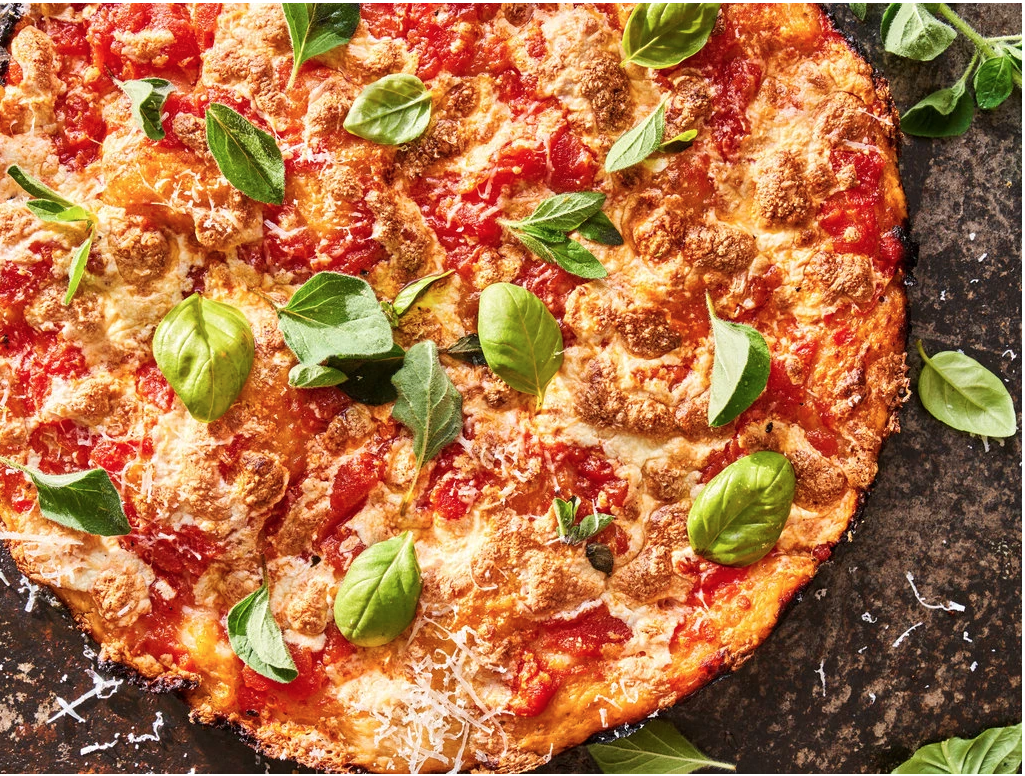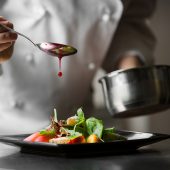Pizza has gone from comfort-food staple to shutdown star during the pandemic, upping the stakes. When we talk pizza, we don’t mean boring old pepperoni or sausage, we’re talking creative takes on the to-go favorite. With pizza, many of the other food trends can be incorporated to really create something unique. Kimchi on pizza? Sure, why not. Comforting chicken and potatoes? Sure, sign me up! Vegan pizza? Of course!
“Pizza allows for the bringing in of trends that is comfortable for consumers because they are comfortable with pizza,” said Luke Zahm of Wisconsin’s Driftless Café during a recent demonstration for the International Foodservice Editorial Council.
In fact, pizza has become so popular that the New York Times included it among its Top 20 Most Popular Recipes of 2020.
The recipe, from King Arthur Flour, is "a crisp, cheesy pan pizza that uses a number of simple techniques to achieve maximum texture and flavor. The dough is folded a few times before it goes in the fridge for a long rest, which develops its flavor and airiness. Cooking the pizza in cast iron gets the edges brown and crackling, and layering the cheese and sauce creates an extra cheesy top with no soggy layer. Make it once in its simplest form, then use the model to play around with the fermentation time and toppings," according to the New York Times.
And for those who are abstaining from meat on Fridays during Lent, this delicious recipe is completely meat-free. Bon Appetit!

Cheesy Pan Piza
Recipe courtesy King Arthur Flour
Yield: 1
Ingredients for dough
1 ¾ cups plus, 2 T all-purpose flour
¾ cup lukewarm water
1 T olive oil
¾ tsp kosher salt
½ tsp instant or active dry yeast
Method
- Prepare the dough: Measure the flour, water, olive oil, salt and yeast into a large mixing bowl. Mix together with your hand or a dough scraper until it forms a shaggy, sticky ball with no dry patches. Cover the bowl using a damp towel or plastic wrap, and let the dough rest for 5 minutes.
- Wet your hand, and reach down between the side of the bowl and the dough, as though you were going to lift the dough out, but instead of lifting, stretch the bottom of the dough up, and fold it over the top. Repeat three more times, turning the bowl 90 degrees each time. Cover the bowl again for 5 minutes, then repeat the folding-and-resting process three more times. After the fourth time, cover the bowl, and let the dough rest, undisturbed, for 40 minutes, then transfer the bowl to the fridge for at least 12 hours or up to 72 hours.
Ingredients for assembly
1 ½ T olive oil
6 oz mozzarella, grated (about 1 ¼ loosely packed cups)
½ cup tomato sauce or pizza sauce
Freshly grated hard cheese, such as Parmesan or pecorino, for garnish (optional)
Fresh herbs, such as basil, marjoram or oregano, for garnish (optional)
Method
- About 3 hours before you want to eat the pizza, get ready for assembly: Pour the olive oil into a well-seasoned 9- or 10-inch cast-iron skillet, and use your fingers to coat the inside of the pan, including the sides. Transfer the dough to the pan, and turn it once to coat both sides with the oil. After coating the dough in oil, press the dough to the edges of the pan, dimpling it with your fingertips. If the dough shrinks back, cover it and let it rest for about 15 minutes, then repeat the pressing and dimpling. At this point, you should be able to smush the dough out and into the edges of the pan, but if not, give it one more 15-minute rest before trying again. Cover the dough, and let it rise for 2 hours at room temperature. It will look soft and jiggle when you gently shake the pan.
- Place one rack at the bottom of the oven and one toward the top (about 4 to 5 inches from the top heating element), then heat the oven to 450 degrees. When you’re ready to bake the pizza, sprinkle a scant 1 cup mozzarella evenly over the crust. Cover the entire dough so none is showing, then dollop small spoonfuls of the sauce over the cheese. Sprinkle the remaining mozzarella on top, and bake on the bottom rack of the oven for 18 to 20 minutes, until the cheese is bubbling and the bottom and edges of the crust are a rich golden brown. (Use a spatula to check the bottom.) If the bottom is brown but the top still seems pale, transfer the pizza to the top rack, and bake for 2 to 4 minutes longer. On the other hand, if the top seems fine but the bottom’s not browned to your liking, leave the pizza on the bottom rack for another 2 to 4 minutes.
- Remove the pizza from the oven, and place the pan on a heatproof surface. Carefully run a table knife or spatula between the edge of the pizza and side of the pan to prevent the cheese from sticking as it cools. Let the pizza cool very briefly; as soon as you feel comfortable doing so, carefully transfer it from the pan to a cooling rack or cutting surface. If garnishing with hard cheese and herbs, add those now. Serve the pizza anywhere from medium-hot to warm, and use kitchen shears or a large pair of scissors to cut it into wedges.



